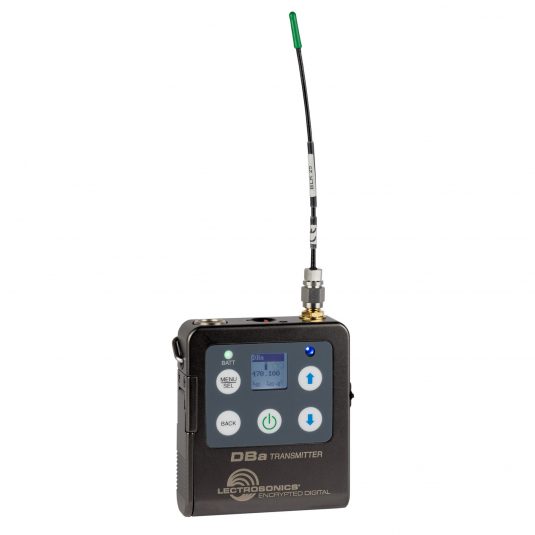Tech Focus: Bodypacks, Part 1 — Transmitters Boost Use of Onfield Audio
Conflicting requirements for greater power and smaller size make their design a complex proposition
Story Highlights
Onfield audio — wiring players, coaches, and officials for sound — has captured sports viewers’ imaginations like few other innovations in broadcasting in recent years. As broadcast sports heads toward the era of immersive sound, those who make the wireless systems that make onfield audio possible see that trend accelerating. In addition, as the next round of league collective-bargaining agreements come up for renewal, the benefits of onfield sound are being recognized in practice: the 2011 NFL CBA codified much of the onfield sound now considered a routine part of football, and the imminent MLB CBA may provide more freedom for sound on the diamond in the future. But there are still plenty of nuts and bolts to be considered.
Size Still Matters; So Does Security
Size continues to be important in the bodypack category, but the trend toward ever smaller transmitters may be nearing a physical cut-off point: batteries simply can’t get much smaller and still deliver the game-long performance required. In addition, teams and leagues are demanding that bodypack transmitters be as robust as possible, creating design challenges for manufacturers.
“They get onfield, so it has to stand up to that and do so without sharp corners or anything that can catch or cut,” notes Karl Winkler, VP, sales, Lectrosonics, whose bodypacks have been used by the NFL and NHL and, starting this season, by several NBA teams (rented through Bexel) as well. “The units can’t get any smaller, really, so it’s a challenge meeting all of the requirements, especially in the current spectrum climate.”
He is referring to ongoing spectrum reallocation, which he says was behind development of a new IFB system that uses the VHF (174-216 MHz) part of the spectrum to free up more UHF bandwidth for broadcast audio.
“What’s happening is that we’re moving the comms audio into VHF in order to leave more room in the UHF range for what people will hear at home,” Winkler explains. “Spectrum loss is making us make better use of what will be left.”
Also of concern is a rising noise floor in wireless, brought about by more devices’ using the 700 MHz and WiFi sections of the RF spectrum in sports venues, collateral to earlier spectrum reallocation. That has been pushing up demand for more-powerful transmitters, in excess of 50 mW. The requirement for larger batteries conflicts with the demand for smaller units, complicating design.
In addition, demand is steadily increasing for more encrypted wireless devices, something Winkler attributes to the attention brought to headset hacking in the last two years.
“The NFL has been using encrypted communications for some time, but they’ve been looking at our new DBa series transmitters, which use 256-bit AES encryption,” he says. “They’re looking for more security. The NBA, too. At the same time, we’re getting requests for secure systems from more college football programs. Security has become a major point of conversation now.”
According to Bill Ostry, senior market development specialist, Shure, both encryption and a more crowded RF environment led to the development of the frequency-diversity technology used on its Axient series wireless systems.
“Teams and leagues are looking for confidence in their ref mics, and frequency coordinators are having a tougher time and are looking for rock-solid RF,” he says. But, he adds, improved wireless systems enable audio to keep up with rapidly improving video for sports. “No matter how many channels of audio you’re broadcasting,” he stresses, “each of those individual channels has to have the highest level of audio quality possible, and they cannot fail.”
Deeper Engagement
Although battery life and size are critical in transmitter design, Paul Johnson, CEO, Quantum 5X, which pioneered onfield audio with its PlayerMic lines, says remote control of the devices is also part of that hierarchy of needs.
“The A1 might do a sound check before an event, but, by the time a venue fills up, the sound in the house will have changed, and there’s no way to reach the unit,” he explains. “Being able to remotely control it becomes important.”
Johnson describes how Fox Sports buried some of its transmitters in the outfield during the World Series; after one of the games, imminent rain compelled the grounds crew to pull a tarp over the field before the audio crew could reach the transmitters to change batteries. However, the crew was able to turn them off remotely and conserve enough power to get them through the next day’s game. Another example Johnson notes is the ability to change audio frequencies on the fly, as RF-challenged spaces in venues have to navigate denser RF environments.
Collectively, all the improvements in design and capability encourage greater use of transmitters, says Johnson. (Battery fires like those Samsung mobile phones have experienced are not a problem for professional-grade wireless systems, he assures.) Currently, MLB umpires and NHL referees use Q5X RefMics, and PlayerMics are deployed in the NBA, NHL, and MLS and by some NFL teams and a growing number of rugby teams. And mid-level colleges and even some high schools are beginning to show interest in onfield sound systems.
“It’s all about deeper fan engagement,” Johnson says. “Player audio is driving fans to players’ and teams’ websites and driving second-screen engagement. Immersive audio is only going to accelerate that.”
CLICK HERE for Tech Focus: Bodypacks, Part 2 — A Look at the Leading Transmitters.

